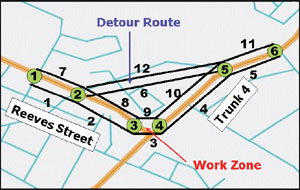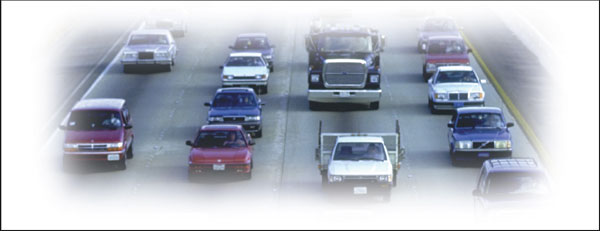U.S. Department of Transportation
Federal Highway Administration
1200 New Jersey Avenue, SE
Washington, DC 20590
202-366-4000
Federal Highway Administration Research and Technology
Coordinating, Developing, and Delivering Highway Transportation Innovations
 |
| This report is an archived publication and may contain dated technical, contact, and link information |
|
Publication Number: FHWA-HRT-05-145
Date: August 2005 |
PDF files can be viewed with the Acrobat® Reader®

In 2001, the intersection of Reeves Street and Trunk 4 in Port Hawkesbury, Nova Scotia— along a key access route to the Trans Canada Highway—was slated to be upgraded. Both roads are generally two-lane roads with certain sections upgraded to include designated turn lanes. Average annual daily traffic (AADT) through the intersection is roughly 8,000 vehicles per day with approximately 10 percent truck volume. Truck traffic is concentrated during the daytime on weekdays. Most of the traffic volume at this location in Port Hawkesbury is through-traffic continuing on to some of the industrial centers near the town or to points further north.
The reconstruction involved a major upgrade of the intersection including additional dedicated turn lanes to accommodate higher traffic volumes and to improve safety. Construction was slated to take place only during daylight hours because of cost and safety concerns. However, it was also evident that any construction during the day would have an impact on motorists. QuickZone Version 1.0 was used to test alternate strategies, including the possibility of a detour route through a residential district.
Under the original traffic control plan, the intersection operated 24 hours a day, 7 days a week. Under these conditions, QuickZone predicted up to a 6.5-kilometer (4.1-mile) queue and 70 minutes of delay. Project engineers noted that queues and delays did not form during the overnight hours on any day, especially Friday. They also tested a scenario that eliminated construction during daylight hours on Fridays and Saturdays. Using this information, construction was planned for mornings and evenings during weekdays. This approach cut in half the queuing and the delays associated with the construction. In addition, the number of vehicles on the detour route was reduced to 6,000 vehicles per week, a 40 percent reduction. The QuickZone analysis allowed project engineers to better plan the construction schedule and make the decision to perform some of the most disruptive phases of construction at night.
KEY OBSERVATIONS
QUICKZONE
Deborah Curtis
Federal Highway Administration
(FHWA) Operations, Research and Development
Integrated Product Team
202–493–3267
deborah.curtis@fhwa.dot.gov
CASE STUDY
Gerard Kennedy, P. E.
Project Engineer
Nova Scotia Department of Transportation and Public Works
902–563–2518
kennedge@gov.ns.ca
